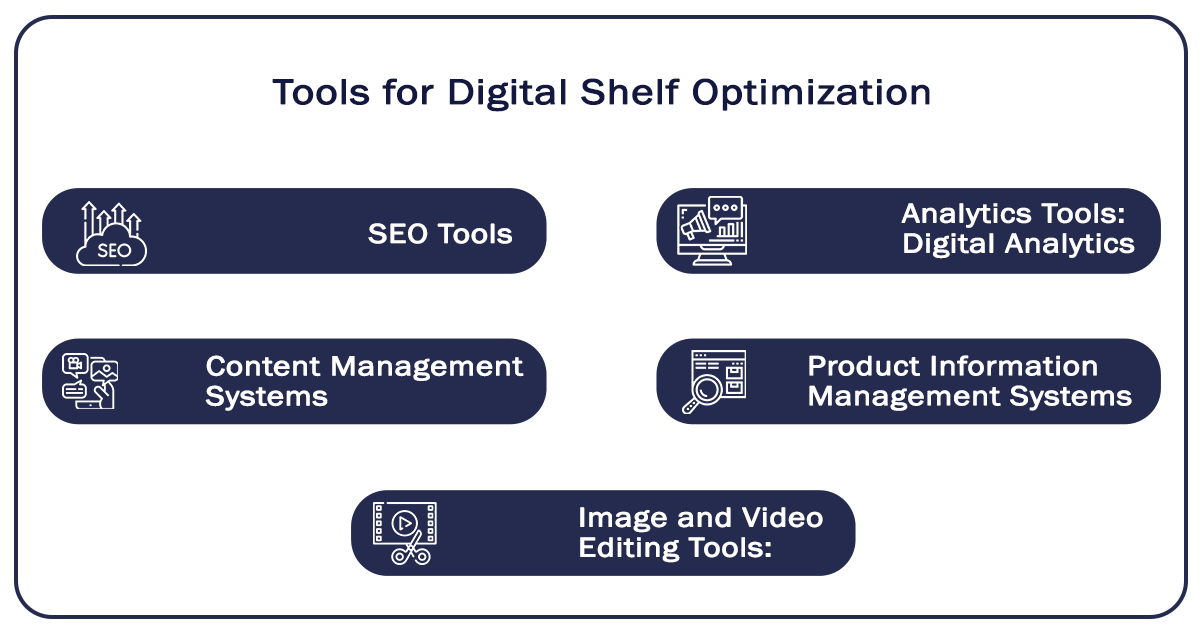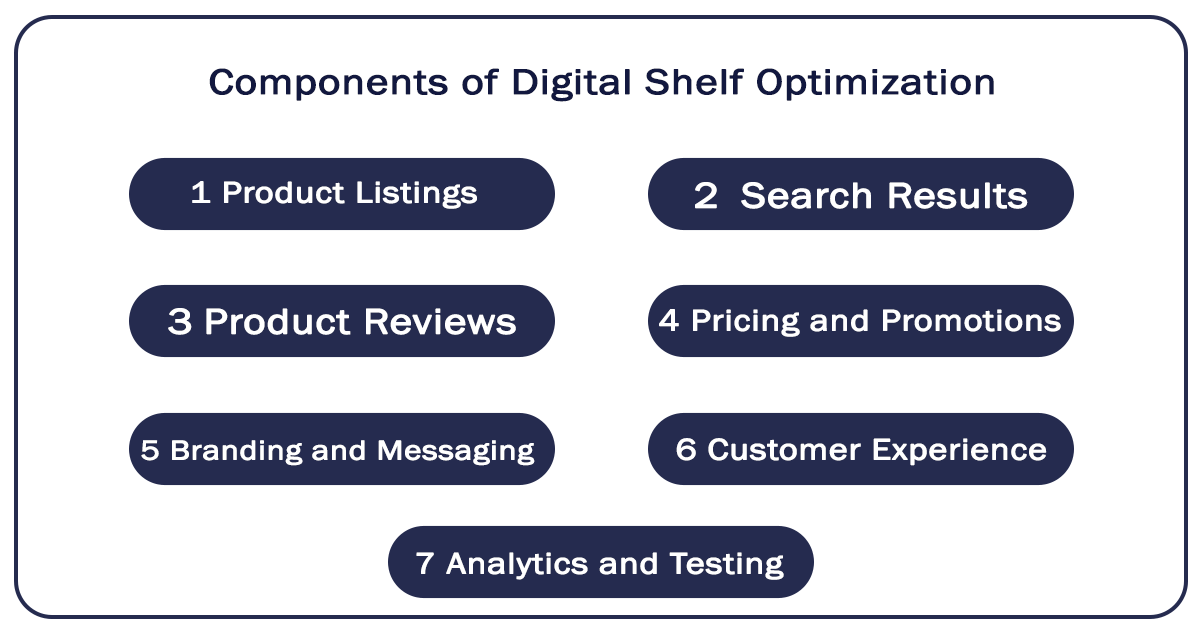
With the increasing popularity of online shopping, businesses recognize the
shift in competition from physical shelves to digital ones. As of 2023, approximately 2.64
million people worldwide, accounting for 33.33% of the population, are already online shopping.
Consequently, businesses prioritize strengthening their online presence to boost sales, enhance
brand engagement, and cultivate customer loyalty.
But what does the term "digital shelf" actually mean? It refers to the virtual
space where consumers explore and make purchasing decisions on e-commerce platforms. Just as
brands compete for visibility and sales in physical stores, they are now vying for attention on
these digital shelves. Being buried beyond the first page of search results is akin to
disappearing into the vast expanse of the Bermuda Triangle for e-commerce; only some will find
you! Research indicates that the top three products displayed on significant retailers' search
engines receive up to 80% of clicks. Therefore, if you want your product to shine brightly on
the digital shelf, striving for those coveted top positions is essential.
The path to securing the top spot on the digital shelf lies in optimization.
Like website optimization is for search engines, brands must optimize their product listings to
align with the algorithms that drive e-commerce websites. It is where Digital Shelf Optimization
(DSO) plays a crucial role. It is an essential aspect of e-commerce as a robust presence on the
digital shelf is vital for brands to differentiate themselves and drive sales.
In this comprehensive guide, we will delve into the significance of DSO in
helping brands achieve their business objectives. Additionally, we will provide valuable tips on
optimizing your digital shelf. Whether you are a budding small business or an established brand,
comprehending the importance of the digital shelf is paramount in today's online marketplace.
About Digital Shelf
The digital shelf represents a virtual aisle where shoppers can explore and
purchase products online. It serves as the platform where brands compete for attention and
sales, mirroring the dynamics of a physical store. The digital shelf encompasses all the digital
touchpoints through which consumers can engage with a brand's products. It encompasses various
channels, from search results and product pages to social media platforms and online
advertisements.
As online shopping continues to gain momentum, the significance of the digital
shelf for brands is growing exponentially. Projections indicate that global e-commerce sales
will reach an astonishing $8.1 trillion by 2026, underscoring this digital retail landscape's
immense potential and impact.
More than merely having a presence on the digital shelf is required for brands
to succeed. They must optimize their listings to stand out amidst the crowded digital
marketplace. It entails employing various strategies, including using relevant keywords,
showcasing high-quality product images and videos, and offering competitive pricing and shipping
options.
About Digital Shelf Optimization

Digital shelf optimization is the art of strategically crafting and enhancing a
brand's presence on the virtual shelves of e-commerce websites. It encompasses various tactics
and strategies to ensure a brand's products are visible, enticing, and easily discoverable for
potential customers.
While search engine optimization (SEO) is vital to digital shelf optimization, it goes beyond
technical aspects. Alongside optimizing product titles and descriptions with relevant keywords,
it involves crafting a compelling brand narrative and messaging that resonates with consumers.
Storytelling becomes a powerful tool to establish an emotional connection and set the brand
apart from competitors.
Additionally, optimizing product content is essential. It includes carefully curating product
descriptions, images, videos, and customer reviews. By optimizing these elements, a brand can
improve its visibility, establish trust and credibility with consumers, and ultimately drive
sales.
However, the most critical aspect of digital shelf optimization revolves around the overall
customer experience. Brands that create a seamless and enjoyable shopping journey for their
customers are more likely to generate sales and foster brand loyalty. It entails intuitive
website design, effortless navigation, personalized product recommendations, and reliable
customer support.
Significance of Digital Shelf Optimization
A digital shelf refers to the online platforms where products are displayed and made available
for customers to browse, compare, and purchase. It encompasses various channels such as search
engines like Google and Bing, popular online marketplaces like Amazon, Walmart, and Target, as
well as a brand's website, social media sites, review platforms, category pages, and product
pages.
Similar to physical store shelves, brands strive to make their products as visible as possible
to attract the attention of potential customers. Digital Shelf Optimization (DSO) is critical in
achieving this visibility and influencing the customer's purchasing journey. It enables
businesses to effectively showcase their products at various stages of the buying process,
ultimately aiming to increase sales.
The changing nature of the customer journey further highlights the significance of DSO. The path
from initial interest to research, consideration, and purchase is no longer linear. Google
refers to this non-linear process as the "messy middle," acknowledging the distractions and
complexities that can occur between sparking interest and completing a purchase.
By improving online content quality, DSO can drive traffic to relevant pages while sustaining
customer interest. Organic search is critical in this regard, as it allows brands to naturally
appear at the top of search results or within their chosen category on retailer websites.
Share Of Search: Share of Search refers to the proportion of overall search
volume that a brand or company receives about its competitors within a specific market or
industry. Based on search engine activity, it is a metric used to gauge a brand's visibility and
popularity. By analyzing search data and calculating the share of searches, businesses can gain
insights into their market position, brand awareness, and competitive landscape.
Content Audit: A content audit systematically assesses and
analyzes a website's existing content. It involves evaluating the quality, relevance, and
performance of all the content assets on a website. A content audit aims to gain a comprehensive
understanding of the website's content, identify areas for improvement, and develop a content
strategy that aligns with business goals.
Assortment and Availability: : Assortment and availability
refer to the range of products or services a brand offers and their accessibility to customers.
It encompasses the variety of options available within a brand's product line or service
offerings and the availability of those products or services to customers in terms of inventory,
stock levels, and distribution channels.
Pricing and Promotions: Pricing and promotions are vital
components of digital shelf optimization, playing a significant role in driving sales and
maximizing brand visibility.
Sales Performance and Market Share: Tracking sales performance
and market share using digital shelf optimization involves leveraging data and analytics to
measure the effectiveness of strategies and monitor a brand's performance in the online
marketplace.
Ratings and Reviews: Tracking ratings and reviews using
digital shelf optimization involves monitoring and analyzing customer feedback and reviews to
gain insights into product satisfaction, brand perception, and reputation management
Components of Digital Shelf Optimization

- Product Listings: Optimizing product listings is crucial for driving sales
on the digital
shelf. To attract customers, brands should ensure their product information is complete,
accurate, and engaging.
- Search Results: Brands can improve their visibility in search results by
utilizing relevant
keywords and optimizing their product listings. It helps them appear higher in search
rankings,
increasing their chances of being discovered by customers.
- Product Reviews: Customer reviews play a significant role in building
trust and credibility on
the digital shelf. Encouraging customers to leave reviews can boost a brand's reputation and
influence potential customers' purchasing decisions.
- Pricing and Promotions: Competitive pricing and attractive promotions drive
sales on the
digital shelf. Brands that offer competitive prices and enticing deals are more likely to
attract customers and stand out.
- Branding and Messaging: Establishing a solid brand identity and crafting
compelling messaging
helps differentiate a brand from competitors and build customer loyalty. A brand's tone of
voice
and overall message should resonate with its target audience.
- Customer Experience: Creating a seamless and enjoyable shopping experience
for customers is
essential on the digital shelf. It includes a user-friendly website design, smooth
navigation,
personalized recommendations, and excellent customer support.
- Analytics and Testing: Utilizing analytics and conducting testing are vital
aspects of digital
shelf optimization. By tracking performance metrics and making data-driven decisions, brands
can
continually improve their strategies and maximize success on the digital shelf.
Primary Key Metrics for Digital Shelf Optimization

Listed below are the critical metrics for digital shelf optimization:
- Search Rankings: This metric gauges a brand's visibility in search results
on e-commerce websites. Higher rankings increase the likelihood of attracting clicks and
driving sales.
- Click-Through Rates (CTR): CTR represents the percentage of people who
click on a brand's product listing after seeing it in search results. Brands with higher
CTRs have a greater chance of driving sales.
- Conversion Rates: Conversion rates measure the percentage of website
visitors who purchase. Higher conversion rates depict that brands are highly effective at
converting visitors into customers.
- Customer Reviews: Reviews play a pivotal role in building trust and
credibility. Brands with more positive reviews are more likely to attract new customers and
drive sales.
- Return Rates: This metric reflects the percentage of customers who return a
purchased product. Higher return rates indicate areas for improvement in product listings or
customer experience to reduce returns.
- Revenue: Revenue measures the total money generated from online sales.
Brands prioritizing optimizing their digital shelf occurrence will likely experience revenue
growth.
Role of DSO in Helping Companies Boost Their Sales
Digital Shelf Optimization (DSO) can significantly contribute to sales growth
for companies in multiple ways. Here are two key ways DSO can drive sales:
Enhanced Visibility and Click-Through Rates: DSO focuses on
improving a product's visibility on the digital shelf, increasing its chances of being
discovered by customers. Companies can improve their search rankings and attract more clicks by
optimizing product listings with relevant keywords, compelling descriptions, and high-quality
visuals. Higher click-through rates lead to increased website traffic and potential sales.
Improved User Experience and Reduced Returns: DSO involves
providing accurate and comprehensive product information on the product pages. By ensuring that
customers have access to detailed and transparent information, companies can enhance the user
experience and reduce the likelihood of returns or dissatisfied customers. Clear and informative
product descriptions, images, and customer reviews help customers make informed purchasing
decisions, resulting in higher customer satisfaction and lower return rates.
Additionally, DSO assists companies in maintaining competitive pricing strategies. Businesses
can make informed pricing decisions by monitoring competitor prices and market trends. Adjusting
prices can attract customers, improve competitiveness, and drive sales growth.
Conclusion:
In conclusion, digital shelf optimization is a critical e-commerce component that enables
businesses to increase revenue, enhance brand engagement, and cultivate customer loyalty. By
refining product listings, personalizing the user experience, fostering user engagement,
monitoring competitors, and analyzing customer data, brands can achieve favorable outcomes in
the competitive digital landscape. While adapting and implementing these strategies may require
time and effort, leveraging analytics and maximizing optimization efforts can propel companies
to succeed on the digital shelf.
At Product Data Scrape, we ensure that our Competitor Price Monitoring Services and Mobile App Data Scraping maintain the highest standards of business ethics and lead all operations. We have multiple offices around the world to fulfill our customers' requirements.












